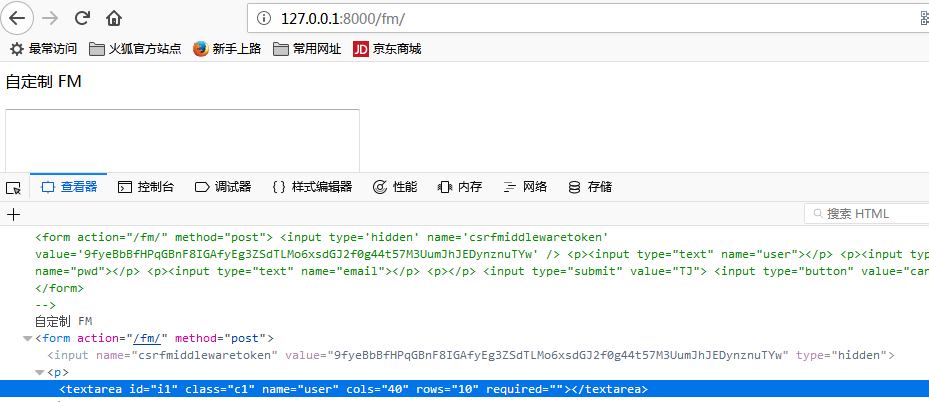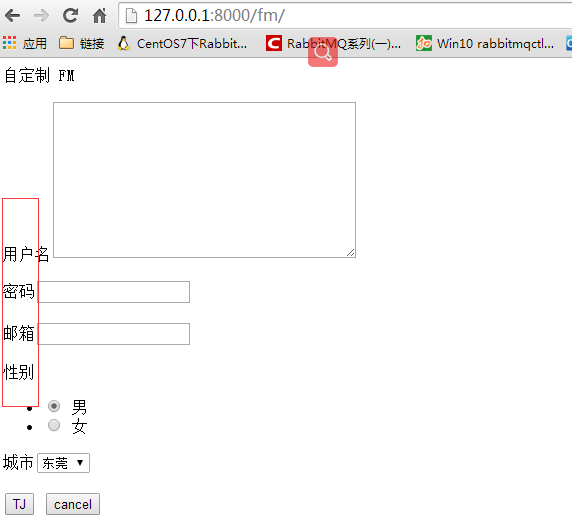day22-django form字段
一、引子
上回中我们学习了form 验证,其中有自动生成HTML 标签,的几种方式,这里就有疑问了,HTML 是怎么生成的,如果我需要控制它的样式怎么办。下面我们就要研究一下这个东西。。。
二、form 字段
form 的html 样式怎么控制呢,需要导入 widgets
1 from django import forms 2 from django.forms import widgets #导入插件模块 3 4 class FM(forms.Form): 5 #获取只关心的数据 6 # user,pwd,email 对应前端的 name属性 , #自定义错误信息 7 user=forms.CharField(error_messages={"required":"用户名不能为空"}, 8 widget=widgets.Textarea(attrs={"id":"i1","class":"c1"}) 9 ) 10 #因为定义了密码长度,所以错误信息里,可以直接用 max_length,min_length 11 pwd=forms.CharField(max_length=16,min_length=8,error_messages={"required":"密码不能为空","max_length":"密码长度不能大于16" 12 ,"min_length":"密码长度不能小于6"}) 13 email=forms.EmailField(error_messages={"required":"邮箱不能为空","invalid":"邮箱格式错误"})

如上图,刚才自定制的 id,class 在前端中现实。
form 还有那些牛逼的功能呢
Django的Form主要具有一下几大功能:
- 生成HTML标签
- 验证用户数据(显示错误信息)
- HTML Form提交保留上次提交数据
- 初始化页面显示内容
小试牛刀,试试其它功能
views
#############form 验证#####
from django import forms
from django.forms import widgets
from django.forms import fields
1 class FM(forms.Form): 2 #获取只关心的数据 3 # user,pwd,email 对应前端的 name属性 , #自定义错误信息 4 user=forms.CharField(error_messages={"required":"用户名不能为空"}, 5 widget=widgets.Textarea(attrs={"id":"i1","class":"c1"}) 6 ) 7 #因为定义了密码长度,所以错误信息里,可以直接用 max_length,min_length 8 # pwd=forms.CharField(max_length=16,min_length=8,error_messages={"required":"密码不能为空","max_length":"密码长度不能大于16" 9 # ,"min_length":"密码长度不能小于6"}) 10 email=forms.EmailField(error_messages={"required":"邮箱不能为空","invalid":"邮箱格式错误"}) 11 12 #fields 实现选择框的功能 13 gender=fields.ChoiceField( 14 initial=1,#默认值 15 choices=((1,"男"),(2,"女")), 16 widget=widgets.RadioSelect 17 ) 18 19 city=fields.CharField( 20 widget=widgets.Select(choices=((1,"上海"),(2,"东莞"))), 21 initial=2 22 ) 23 24 #使用插件,输入字符时,显示* 25 pwd=fields.CharField( 26 widget=widgets.PasswordInput(attrs={"id":"pwd","class":"c2"}) 27 )
html
1 自定制 FM 2 <form action="/fm/" method="post"> 3 {% csrf_token %} 4 <p>{{ obj.user }}{{ obj.errors.user.0 }}</p> 5 <p>{{ obj.pwd }}{{ error.errors.pwd.0 }}</p> 6 <p>{{ obj.email }}{{ error.errors.email.0 }}</p> 7 <p></p> 8 <p>{{ obj.gender }}</p> 9 <p>{{ obj.city }}</p> 10 11 12 <input type="submit" value="TJ"> 13 <input type="button" value="cancel"> 14 15 </form>
其它字段
创建Form类时,主要涉及到 【字段】 和 【插件】,字段用于对用户请求数据的验证,插件用于自动生成HTML;
2.1、Django内置字段如下:
|
1
2
3
4
5
6
7
8
9
10
11
12
13
14
15
16
17
18
19
20
21
22
23
24
25
26
27
28
29
30
31
32
33
34
35
36
37
38
39
40
41
42
43
44
45
46
47
48
49
50
51
52
53
54
55
56
57
58
59
60
61
62
63
64
65
66
67
68
69
70
71
72
73
74
75
76
77
78
79
80
81
82
83
84
85
86
87
88
89
90
91
92
93
94
95
96
97
98
99
100
101
102
103
104
105
106
107
108
109
110
111
112
113
114
115
116
117
118
119
120
121
122
123
124
125
126
127
128
129
130
131
132
133
134
135
136
|
Field required=True, 是否允许为空 widget=None, HTML插件 label=None, 用于生成Label标签或显示内容 initial=None, 初始值 help_text='', 帮助信息(在标签旁边显示) error_messages=None, 错误信息 {'required': '不能为空', 'invalid': '格式错误'} show_hidden_initial=False, 是否在当前插件后面再加一个隐藏的且具有默认值的插件(可用于检验两次输入是否一直) validators=[], 自定义验证规则,这个是自定义正则表达式,(具体内容请看,自定义验证规则) localize=False, 是否支持本地化 disabled=False, 是否可以编辑 label_suffix=None Label内容后缀 CharField(Field) max_length=None, 最大长度 min_length=None, 最小长度 strip=True 是否移除用户输入空白 IntegerField(Field) max_value=None, 最大值 min_value=None, 最小值 FloatField(IntegerField) ... DecimalField(IntegerField) max_value=None, 最大值 min_value=None, 最小值 max_digits=None, 总长度 decimal_places=None, 小数位长度 BaseTemporalField(Field) input_formats=None 时间格式化 DateField(BaseTemporalField) 格式:2015-09-01TimeField(BaseTemporalField) 格式:11:12DateTimeField(BaseTemporalField)格式:2015-09-01 11:12 DurationField(Field) 时间间隔:%d %H:%M:%S.%f ... RegexField(CharField) regex, 自定制正则表达式 max_length=None, 最大长度 min_length=None, 最小长度 error_message=None, 忽略,错误信息使用 error_messages={'invalid': '...'} EmailField(CharField) ... FileField(Field) allow_empty_file=False 是否允许空文件 ImageField(FileField) ... 注:需要PIL模块,pip3 install Pillow 以上两个字典使用时,需要注意两点: - form表单中 enctype="multipart/form-data" - view函数中 obj = MyForm(request.POST, request.FILES) URLField(Field) ... BooleanField(Field) ... NullBooleanField(BooleanField) ... ChoiceField(Field) ... choices=(), 选项,如:choices = ((0,'上海'),(1,'北京'),) required=True, 是否必填 widget=None, 插件,默认select插件 label=None, Label内容 initial=None, 初始值 help_text='', 帮助提示 ModelChoiceField(ChoiceField) ... django.forms.models.ModelChoiceField queryset, # 查询数据库中的数据 empty_label="---------", # 默认空显示内容 to_field_name=None, # HTML中value的值对应的字段 limit_choices_to=None # ModelForm中对queryset二次筛选 ModelMultipleChoiceField(ModelChoiceField) ... django.forms.models.ModelMultipleChoiceField TypedChoiceField(ChoiceField) coerce = lambda val: val 对选中的值进行一次转换 empty_value= '' 空值的默认值 MultipleChoiceField(ChoiceField) ... TypedMultipleChoiceField(MultipleChoiceField) coerce = lambda val: val 对选中的每一个值进行一次转换 empty_value= '' 空值的默认值 ComboField(Field) fields=() 使用多个验证,如下:即验证最大长度20,又验证邮箱格式 fields.ComboField(fields=[fields.CharField(max_length=20), fields.EmailField(),]) MultiValueField(Field) PS: 抽象类,子类中可以实现聚合多个字典去匹配一个值,要配合MultiWidget使用 SplitDateTimeField(MultiValueField) input_date_formats=None, 格式列表:['%Y--%m--%d', '%m%d/%Y', '%m/%d/%y'] input_time_formats=None 格式列表:['%H:%M:%S', '%H:%M:%S.%f', '%H:%M'] FilePathField(ChoiceField) 文件选项,目录下文件显示在页面中 path, 文件夹路径 match=None, 正则匹配 recursive=False, 递归下面的文件夹 allow_files=True, 允许文件 allow_folders=False, 允许文件夹 required=True, widget=None, label=None, initial=None, help_text='' GenericIPAddressField protocol='both', both,ipv4,ipv6支持的IP格式 unpack_ipv4=False 解析ipv4地址,如果是::ffff:192.0.2.1时候,可解析为192.0.2.1, PS:protocol必须为both才能启用 SlugField(CharField) 数字,字母,下划线,减号(连字符) ... UUIDField(CharField) uuid类型 ... |
下面搞几个小栗子
1.label
1 #############form 验证##### 把form 类写在单独的 py 文件中,与views 分开规范化 2 from django import forms 3 from django.forms import widgets 4 from django.forms import fields 5 6 class FM(forms.Form): 7 #获取只关心的数据 8 # user,pwd,email 对应前端的 name属性 , #自定义错误信息 9 user=forms.CharField(error_messages={"required":"用户名不能为空"}, 10 widget=widgets.Textarea(attrs={"id":"i1","class":"c1"}), 11 label="用户名" 12 ) 13 #因为定义了密码长度,所以错误信息里,可以直接用 max_length,min_length 14 # pwd=forms.CharField(max_length=16,min_length=8,error_messages={"required":"密码不能为空","max_length":"密码长度不能大于16" 15 # ,"min_length":"密码长度不能小于6"}) 16 email=forms.EmailField(error_messages={"required":"邮箱不能为空","invalid":"邮箱格式错误"}, 17 label="邮箱") 18 19 #fields 实现选择框的功能 20 gender=fields.ChoiceField( 21 initial=1,#默认值 22 choices=((1,"男"),(2,"女")), 23 widget=widgets.RadioSelect, 24 label="性别" 25 ) 26 27 city=fields.CharField( 28 widget=widgets.Select(choices=((1,"上海"),(2,"东莞"))), 29 initial=2, 30 label="城市" 31 ) 32 33 #使用插件,输入字符时,显示* 34 pwd=fields.CharField( 35 widget=widgets.PasswordInput(attrs={"id":"pwd","class":"c2"}), 36 label="密码" 37 )
2 html
1 自定制 FM 2 <form action="/fm/" method="post"> 3 {% csrf_token %} 4 <p>{{ obj.user.label }}{{ obj.user }}{{ obj.errors.user.0 }}</p> 5 <p>{{ obj.pwd.label }}{{ obj.pwd }}{{ error.errors.pwd.0 }}</p> 6 <p>{{ obj.email.label }}{{ obj.email }}{{ error.errors.email.0 }}</p> 7 <p></p> 8 <p>{{ obj.gender.label }}{{ obj.gender }}</p> 9 <p>{{ obj.city.label }}{{ obj.city }}</p> 10 11 12 <input type="submit" value="TJ"> 13 <input type="button" value="cancel"> 14 15 </form> 16 <!--
效果

注:UUID是根据MAC以及当前时间等创建的不重复的随机字符串
1 >>> import uuid 2 3 # make a UUID based on the host ID and current time 4 >>> uuid.uuid1() # doctest: +SKIP 5 UUID('a8098c1a-f86e-11da-bd1a-00112444be1e') 6 7 # make a UUID using an MD5 hash of a namespace UUID and a name 8 >>> uuid.uuid3(uuid.NAMESPACE_DNS, 'python.org') 9 UUID('6fa459ea-ee8a-3ca4-894e-db77e160355e') 10 11 # make a random UUID 12 >>> uuid.uuid4() # doctest: +SKIP 13 UUID('16fd2706-8baf-433b-82eb-8c7fada847da') 14 15 # make a UUID using a SHA-1 hash of a namespace UUID and a name 16 >>> uuid.uuid5(uuid.NAMESPACE_DNS, 'python.org') 17 UUID('886313e1-3b8a-5372-9b90-0c9aee199e5d') 18 19 # make a UUID from a string of hex digits (braces and hyphens ignored) 20 >>> x = uuid.UUID('{00010203-0405-0607-0809-0a0b0c0d0e0f}') 21 22 # convert a UUID to a string of hex digits in standard form 23 >>> str(x) 24 '00010203-0405-0607-0809-0a0b0c0d0e0f' 25 26 # get the raw 16 bytes of the UUID 27 >>> x.bytes 28 b'\x00\x01\x02\x03\x04\x05\x06\x07\x08\t\n\x0b\x0c\r\x0e\x0f' 29 30 # make a UUID from a 16-byte string 31 >>> uuid.UUID(bytes=x.bytes) 32 UUID('00010203-0405-0607-0809-0a0b0c0d0e0f') 33 34 uuid
2.2、Django内置插件
说明:就是说这边内置的插件就是在html里面中显示什么标签,widget=None,HTML插件,支持下面的:
|
1
2
3
4
5
6
7
8
9
10
11
12
13
14
15
16
17
18
19
20
21
22
|
TextInput(Input)NumberInput(TextInput)EmailInput(TextInput)URLInput(TextInput)PasswordInput(TextInput)HiddenInput(TextInput)Textarea(Widget)DateInput(DateTimeBaseInput)DateTimeInput(DateTimeBaseInput)TimeInput(DateTimeBaseInput)CheckboxInputSelectNullBooleanSelectSelectMultipleRadioSelectCheckboxSelectMultipleFileInputClearableFileInputMultipleHiddenInputSplitDateTimeWidgetSplitHiddenDateTimeWidgetSelectDateWidget |
具体使用如下:
|
1
|
user = fields.CharField(widget=widgets.Textarea(attrs={'class':'c1','id':'username'})) #这边使用Textarea插件 |
常用选择插件:

# 单radio,值为字符串
# user = fields.CharField(
# initial=2,
# widget=widgets.RadioSelect(choices=((1,'上海'),(2,'北京'),))
# )
# 单radio,值为字符串
# user = fields.ChoiceField(
# choices=((1, '上海'), (2, '北京'),),
# initial=2,
# widget=widgets.RadioSelect
# )
# 单select,值为字符串
# user = fields.CharField(
# initial=2,
# widget=widgets.Select(choices=((1,'上海'),(2,'北京'),))
# )
# 单select,值为字符串
# user = fields.ChoiceField(
# choices=((1, '上海'), (2, '北京'),),
# initial=2,
# widget=widgets.Select
# )
# 多选select,值为列表
# user = fields.MultipleChoiceField(
# choices=((1,'上海'),(2,'北京'),),
# initial=[1,],
# widget=widgets.SelectMultiple
# )
# 单checkbox
# user = fields.CharField(
# widget=widgets.CheckboxInput()
# )
# 多选checkbox,值为列表
# user = fields.MultipleChoiceField(
# initial=[2, ],
# choices=((1, '上海'), (2, '北京'),),
# widget=widgets.CheckboxSelectMultiple
# )
常用选择的插件
# 单radio,值为字符串 # user = fields.CharField( # initial=2, # widget=widgets.RadioSelect(choices=((1,'上海'),(2,'北京'),)) # ) # 单radio,值为字符串 # user = fields.ChoiceField( # choices=((1, '上海'), (2, '北京'),), # initial=2, # widget=widgets.RadioSelect # ) # 单select,值为字符串 # user = fields.CharField( # initial=2, # widget=widgets.Select(choices=((1,'上海'),(2,'北京'),)) # ) # 单select,值为字符串 # user = fields.ChoiceField( # choices=((1, '上海'), (2, '北京'),), # initial=2, # widget=widgets.Select # ) # 多选select,值为列表 # user = fields.MultipleChoiceField( # choices=((1,'上海'),(2,'北京'),), # initial=[1,], # widget=widgets.SelectMultiple # ) # 单checkbox # user = fields.CharField( # widget=widgets.CheckboxInput() # ) # 多选checkbox,值为列表 # user = fields.MultipleChoiceField( # initial=[2, ], # choices=((1, '上海'), (2, '北京'),), # widget=widgets.CheckboxSelectMultiple # )
在使用选择标签时,需要注意choices的选项可以从数据库中获取,但是由于是静态字段 ***获取的值无法实时更新***,那么需要自定义构造方法从而达到此目的。
方式一:
|
1
2
3
4
5
6
7
8
9
10
11
12
13
14
15
16
17
18
|
from django.forms import Formfrom django.forms import widgetsfrom django.forms import fieldsfrom django.core.validators import RegexValidator class MyForm(Form): user = fields.ChoiceField( # choices=((1, '上海'), (2, '北京'),), initial=2, widget=widgets.Select ) def __init__(self, *args, **kwargs): super(MyForm,self).__init__(*args, **kwargs) # self.fields['user'].widget.choices = ((1, '上海'), (2, '北京'),) # 或 self.fields['user'].widget.choices = models.Classes.objects.all().value_list('id','caption') |
方式二:
使用django提供的ModelChoiceField和ModelMultipleChoiceField字段来实现
|
1
2
3
4
5
6
7
8
9
10
|
from django import formsfrom django.forms import fieldsfrom django.forms import widgetsfrom django.forms import models as form_modelfrom django.core.exceptions import ValidationErrorfrom django.core.validators import RegexValidator class FInfo(forms.Form): authors = form_model.ModelMultipleChoiceField(queryset=models.NNewType.objects.all()) # authors = form_model.ModelChoiceField(queryset=models.NNewType.objects.all()) |
三、自定义验证规则
3.1、方式一
|
1
2
3
4
5
6
7
8
9
|
from django.forms import Formfrom django.forms import widgetsfrom django.forms import fieldsfrom django.core.validators import RegexValidator class MyForm(Form): user = fields.CharField( validators=[RegexValidator(r'^[0-9]+$', '请输入数字'), RegexValidator(r'^159[0-9]+$', '数字必须以159开头')], ) #这个字段采用了两个验证方式,前面是匹配规则,后面是错误提示 |
3.2、方式二

import re
from django.forms import Form
from django.forms import widgets
from django.forms import fields
from django.core.exceptions import ValidationError
# 自定义验证规则
def mobile_validate(value):
mobile_re = re.compile(r'^(13[0-9]|15[012356789]|17[678]|18[0-9]|14[57])[0-9]{8}$')
if not mobile_re.match(value):
raise ValidationError('手机号码格式错误')
class PublishForm(Form):
title = fields.CharField(max_length=20,
min_length=5,
error_messages={'required': '标题不能为空',
'min_length': '标题最少为5个字符',
'max_length': '标题最多为20个字符'},
widget=widgets.TextInput(attrs={'class': "form-control",
'placeholder': '标题5-20个字符'}))
# 使用自定义验证规则
phone = fields.CharField(validators=[mobile_validate, ],
error_messages={'required': '手机不能为空'},
widget=widgets.TextInput(attrs={'class': "form-control",
'placeholder': u'手机号码'}))
email = fields.EmailField(required=False,
error_messages={'required': u'邮箱不能为空','invalid': u'邮箱格式错误'},
widget=widgets.TextInput(attrs={'class': "form-control", 'placeholder': u'邮箱'}))
方式二
import re
from django.forms import Form
from django.forms import widgets
from django.forms import fields
from django.core.exceptions import ValidationError
# 自定义验证规则
def mobile_validate(value):
mobile_re = re.compile(r'^(13[0-9]|15[012356789]|17[678]|18[0-9]|14[57])[0-9]{8}$')
if not mobile_re.match(value):
raise ValidationError('手机号码格式错误')
class PublishForm(Form):
title = fields.CharField(max_length=20,
min_length=5,
error_messages={'required': '标题不能为空',
'min_length': '标题最少为5个字符',
'max_length': '标题最多为20个字符'},
widget=widgets.TextInput(attrs={'class': "form-control",
'placeholder': '标题5-20个字符'}))
# 使用自定义验证规则
phone = fields.CharField(validators=[mobile_validate, ],
error_messages={'required': '手机不能为空'},
widget=widgets.TextInput(attrs={'class': "form-control",
'placeholder': u'手机号码'}))
email = fields.EmailField(required=False,
error_messages={'required': u'邮箱不能为空','invalid': u'邮箱格式错误'},
widget=widgets.TextInput(attrs={'class': "form-control", 'placeholder': u'邮箱'}))
3.3、方法三
说明:自定义方法

from django import forms
from django.forms import fields
from django.forms import widgets
from django.core.exceptions import ValidationError
from django.core.validators import RegexValidator
class FInfo(forms.Form):
username = fields.CharField(max_length=5,
validators=[RegexValidator(r'^[0-9]+$', 'Enter a valid extension.', 'invalid')], )
email = fields.EmailField()
def clean_username(self):
"""
Form中字段中定义的格式匹配完之后,执行此方法进行验证
:return:
"""
value = self.cleaned_data['username']
if "666" in value:
raise ValidationError('666已经被玩烂了...', 'invalid')
return value
自定义方法
from django import forms
from django.forms import fields
from django.forms import widgets
from django.core.exceptions import ValidationError
from django.core.validators import RegexValidator
class FInfo(forms.Form):
username = fields.CharField(max_length=5,
validators=[RegexValidator(r'^[0-9]+$', 'Enter a valid extension.', 'invalid')], )
email = fields.EmailField()
def clean_username(self):
"""
Form中字段中定义的格式匹配完之后,执行此方法进行验证
:return:
"""
value = self.cleaned_data['username']
if "666" in value:
raise ValidationError('666已经被玩烂了...', 'invalid')
return value
3.4、方法四
说明:同时生成多个标签进行验证

from django.forms import Form
from django.forms import widgets
from django.forms import fields
from django.core.validators import RegexValidator
############## 自定义字段 ##############
class PhoneField(fields.MultiValueField):
def __init__(self, *args, **kwargs):
# Define one message for all fields.
error_messages = {
'incomplete': 'Enter a country calling code and a phone number.',
}
# Or define a different message for each field.
f = (
fields.CharField(
error_messages={'incomplete': 'Enter a country calling code.'},
validators=[
RegexValidator(r'^[0-9]+$', 'Enter a valid country calling code.'),
],
),
fields.CharField(
error_messages={'incomplete': 'Enter a phone number.'},
validators=[RegexValidator(r'^[0-9]+$', 'Enter a valid phone number.')],
),
fields.CharField(
validators=[RegexValidator(r'^[0-9]+$', 'Enter a valid extension.')],
required=False,
),
)
super(PhoneField, self).__init__(error_messages=error_messages, fields=f, require_all_fields=False, *args,
**kwargs)
def compress(self, data_list):
"""
当用户验证都通过后,该值返回给用户
:param data_list:
:return:
"""
return data_list
############## 自定义插件 ##############
class SplitPhoneWidget(widgets.MultiWidget):
def __init__(self):
ws = (
widgets.TextInput(),
widgets.TextInput(),
widgets.TextInput(),
)
super(SplitPhoneWidget, self).__init__(ws)
def decompress(self, value):
"""
处理初始值,当初始值initial不是列表时,调用该方法
:param value:
:return:
"""
if value:
return value.split(',')
return [None, None, None]
生成多个标签验证
from django.forms import Form
from django.forms import widgets
from django.forms import fields
from django.core.validators import RegexValidator
############## 自定义字段 ##############
class PhoneField(fields.MultiValueField):
def __init__(self, *args, **kwargs):
# Define one message for all fields.
error_messages = {
'incomplete': 'Enter a country calling code and a phone number.',
}
# Or define a different message for each field.
f = (
fields.CharField(
error_messages={'incomplete': 'Enter a country calling code.'},
validators=[
RegexValidator(r'^[0-9]+$', 'Enter a valid country calling code.'),
],
),
fields.CharField(
error_messages={'incomplete': 'Enter a phone number.'},
validators=[RegexValidator(r'^[0-9]+$', 'Enter a valid phone number.')],
),
fields.CharField(
validators=[RegexValidator(r'^[0-9]+$', 'Enter a valid extension.')],
required=False,
),
)
super(PhoneField, self).__init__(error_messages=error_messages, fields=f, require_all_fields=False, *args,
**kwargs)
def compress(self, data_list):
"""
当用户验证都通过后,该值返回给用户
:param data_list:
:return:
"""
return data_list
############## 自定义插件 ##############
class SplitPhoneWidget(widgets.MultiWidget):
def __init__(self):
ws = (
widgets.TextInput(),
widgets.TextInput(),
widgets.TextInput(),
)
super(SplitPhoneWidget, self).__init__(ws)
def decompress(self, value):
"""
处理初始值,当初始值initial不是列表时,调用该方法
:param value:
:return:
"""
if value:
return value.split(',')
return [None, None, None]
四、初始化数据
在Web应用程序中开发编写功能时,时常用到获取数据库中的数据并将值初始化在HTML中的标签上。
4.1、Form
|
1
2
3
4
5
6
7
8
9
10
11
12
13
|
from django.forms import Formfrom django.forms import widgetsfrom django.forms import fieldsfrom django.core.validators import RegexValidator class MyForm(Form): user = fields.CharField() city = fields.ChoiceField( choices=((1, '上海'), (2, '北京'),), widget=widgets.Select ) |
4.2、Views
|
1
2
3
4
5
6
7
8
9
10
11
12
13
14
|
from django.shortcuts import render, redirectfrom .forms import MyForm def index(request): if request.method == "GET": values = {'user': 'root', 'city': 2} obj = MyForm(values) return render(request, 'index.html', {'form': obj}) elif request.method == "POST": return redirect('http://www.google.com') else: return redirect('http://www.google.com') |
4.3、HTML
|
1
2
3
4
5
6
7
|
<form method="POST" enctype="multipart/form-data"> {% csrf_token %} <p>{{ form.user }} {{ form.user.errors }}</p> <p>{{ form.city }} {{ form.city.errors }}</p> <input type="submit"/></form> |




 浙公网安备 33010602011771号
浙公网安备 33010602011771号